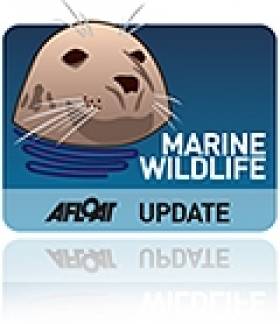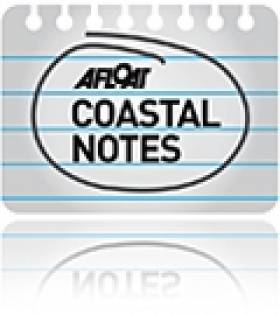Displaying items by tag: aquarium
Dragonfish Discovery in River Suck Highlights Danger of Illegal Aquarium Releases to Native Wildlife
#marinewildlife – The recent discovery by a local angler of the decaying remains of an exotic fish specimen in the River Suck at Correen Ford in the Midlands has raised further concern of the threat to our native wildlife from aquarium releases by otherwise well-meaning individuals. This latest discovery followed by that of a Yellow-bellied Slider turtle on the River Maigue, in Co. Limerick last week.
Despite the partially decomposed state of the fish, Inland Fisheries Ireland (IFI) staff, in consultation with international experts, believe the six inch-long, sharp-toothed specimen to be a Dragonfish (also known as a Violet or Dragon Goby). This fish is native to North and South America and can be purchased in Ireland for private aquariums.
As it is regarded as a warm water species, the Dragonfish is not considered to be able to survive in the wild in Ireland. However, according to Dr Joe Caffrey, Senior Research Officer with IFI, "There are many exotic species of potential concern sold in the aquarium trade in Ireland. These include non-native freshwater fishes, crayfish and aquatic plants. If these are released to the wild they could seriously threaten our native biodiversity and ecosystem function, and the continued conservation of internationally important native species in our rivers and lakes. It is imperative that the public and all stakeholders are aware of the potential damage that exotic animals or plants which are deliberately introduced to the wild can inflict upon our unique wildlife and habitats."
In recent years, human-mediated introductions of non-native species such as Asian Clam, Australian Swamp Stonecrop, South African Pondweed and Zebra Mussel into Irish waterways have resulted in detrimental impacts to native species and habitats, degraded the amenity value of areas that become infested and required costly control measures to be implemented to mitigate these impacts.
Under the European Communities Birds and Natural Habitats Regulations 2011, the unlicensed release to the wild of any animal species, which is not ordinarily resident in Ireland or a regular visitor to the country, in a wild state is an offence.
Any sightings of exotic plants or animals found in or around our waterways can be reported to IFI through the 'IFI Invasive Species' smart phone app which is available to download from the Google Play and iTunes App stores.
The app aids users to report and identify exotic species and take geo-referenced photographs that can immediately be sent to IFI scientists for review. If the sighting is of something new or particularly worrying, this will trigger an immediate on-site survey by IFI staff. IFI want as many people as possible to use this app and help it in its ongoing battle against aquatic invasive species.
#MarineWildlife - BBC News reports that Northern Ireland's Exploris aquarium will remain open for another two months as Ards Borough Council prepares to submit its business plan to save the facility in April.
As previously reported on Afloat.ie, the popular but loss-making tourist attraction was earmarked for closure last year - threatening the future of its more than 3,000 marine animals - but saved at the 11th hour, provided the council receives a one-off capital grant of more than €1 million from Stormont.
It's hoped that this funding would be confirmed and the aquarium will get the green light to remain operational when the NI Executive makes its decision on the plan.
That would mean Exploris could stay open for the peak spring/summer period, and close in October for a necessary six-month refurbishment over winter and next spring.
BBC News has more on the story HERE.
Portaferry Aquarium 'Saved' Pending £900k Govt Grant
#MarineWildlife - Northern Ireland's Exploris aquarium will be saved - provided the local council receives a one-off capital grant from Stormont.
BBC News reports that a new business plan to preserve the Portaferry aquarium, which is one of the North's biggest tourist attractions, has been agreed.
But the plan's success is subject to funding of £900,000 (€1.09 million) from the NI Executive as part of a financial rescue package for the facility.
Ards Borough Council, which has run the Co Antrim aquarium since its opening in 1987, says it can no longer afford its annual operating costs of some £500,000 (€600,000).
And its closure could see more than 3,000 marine animals presently housed in the facility destroyed.
Should the new funding be confirmed, Ards Borough Council would keep Exploris open for this year's peak spring/summer period before closing for a six-month refurbishment in the autumn.
The business plan for Exploris would also preserve the aquarium's seal sanctuary, although its own future was confirmed by Environment Minister Mark Durkan in November.
BBC News has more on the story HERE.
#COASTAL NOTES - Northern Ireland's only aquarium could be privatised, according to the News Letter.
Ards Borough Council is reportedly considering its options for the future of Exploris, the aquarium and seal sanctuary in Portaferry that celebrates its 25th anniversary this year.
Plans were made four years ago to transfer ownership to English aquarium group Blue Reef Leisure, but the deal fell through when that firm was aquired by Spain's Aspro.
Now the council has announced it is calling for proposals for private investment in the Exploris facility - which costs around £500,000 (€600,000) a year to run - following "renewed interest from the public sector".
The move aims to "establish a clear direction for the future of Exploris", which houses one of Northern Ireland's top 10 visitor attractions in its popular seal sanctuary.
The News Letter has more on the story HERE.
Ocean Day Events at Galway Aquarium
Galway's National Aquarium is pushing the boat out for World Ocean Day on Sunday, with Bjorn the Polar Bear the main attraction. Bjorn and handler Ursula are among a line-up of special guests that include wildlife filmmaker Vincent Hyland, a diving world record holder, and the Irish Seal Sanctuary. There will be three Polar Bear shows, 11.00, 1.00 and 3.00pm (Tickets will be allocated for each show, early arrival is advisable!) The Aquarium is open from 10.00am to 5.00pm General Admission will apply except for a Special Family Ticket (2 Adults + 2 Children) only 25.00 euros Tickets valid all day and include all activities For more information contact us at the aquarium on 091 585100 or email [email protected]





























































